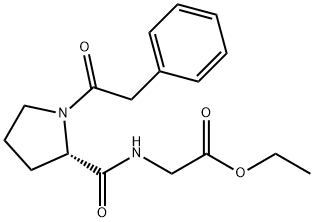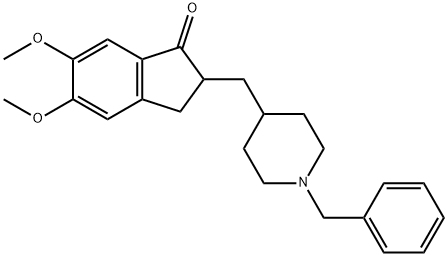Noopept
Synonym(s):1-(2-Phenylacetyl)-L-prolyl-glycine ethyl ester;GVS 111;N-Phenylacetyl-L-prolylglycine ethyl ester;SGS 111
- CAS NO.:157115-85-0
- Empirical Formula: C17H22N2O4
- Molecular Weight: 318.37
- MDL number: MFCD00941121
- EINECS: 1592732-453-0
- SAFETY DATA SHEET (SDS)
- Update Date: 2024-11-20 17:10:30

What is Noopept?
Description
Noopept is the brand name for N-phenylacetyl-L-prolylglycine ethyl ester , a synthetic nootropic molecule. It has a similar effect to piracetam, in that it provides a mild cognitive boost after supplementation. It also provides a subtle psychostimulatory effect. Noopept is up to 1000-times more potent than the original racetam, Piracetam.
Chemical properties
Noopept is a synthetic nootropic molecule grouped in the racetam class but structurally different from racetams.It is primarily water-soluble nootropic, but won't easily dissolve in water or juice. So it may help if you take it with a meal containing healthy fats.
History
Noopept (previously GVS-111) is a nootropic developed at the Zakusov Institute of Pharmacology (Russian Academy of Medical Sciences) by T. A. Gudasheva. It is one of several nootropics developed based on the structure of piracetam. Its advantage over piracetam is that it can be taken at a lower dose.
Noopept is a popular cognitive-enhancing supplement in the nootropic community. Proposed mechanism of actions based on preclinical studies include increasing acetylcholine signaling, increasing the expression of BDNF and NGF, protecting from glutamate toxicity, and increasing inhibitory neurotransmission in the brain.
www.alzdiscovery.org
The Uses of Noopept
Noopept is a well-known nootropic that is often suggested as a first nootropic.Noopept is over 500 times more potentthan Piracetam.Like piracetam,it is capable of enhancing memory,learning,andfocus. Noopept is also a powerful antioxidant that prevents neurological disorders andhelps the brain grow.Because of this, it is thought to improve long-term memory. The human studies have shown promising results, with potential application in the treatment of Alzheimer's disease.
Biochem/physiol Actions
Noopept is a nootropic and neuroprotective drug that normalizes the balance of the pro- and antioxidant systems. Noopept modulates a variety of physiological functions including cognition and anxiety. Noopept significantly weakens streptozotocin-Induced diabetes in rats.
Mechanism of action
Noopept is believed to amplify acetylcholine activity in the body. The reason this is noteworthy is that acetylcholine is known as the "learning transmitter" due to its impact on learning. It’s also involved in memory, cognition, and the mind-muscle connection. Noopept has also been shown to upregulate the expression of both NGF and BDNF, two important brain proteins that impact cognition and memory. Animal models also indicate that noopept modulates both the AMPA and NMDA receptors, helping to prevent glutamate toxicity, while also enhancing neuroplasticity. Noopept is also known as a powerful neuroprotectant due to its anti-inflammatory and antioxidant properties.
Side Effects
Noopept is associated with some mild side effects based on limited clinical evidence. possible side effects of noopept included sleep disturbances (5/31 patients), irritability (3/31), and increased blood pressure (7/31) (Neznamov and Teleshova, 2009).
Preparation
Noopept (ethyl ester of N-phenylacetyl-L-prolylglycine) was designed as a drug at State Zakusov Institute of Pharmacology. The synthesis of the drug is based on the original hypothesis of peptide design, according to which structures similar to known psychotropic agents are reproduced using appropriate amino acids. The non-peptide prototype of Noopept is the nootropic drug Piracetam.
1. Perform the carboxylation of N-phenylacetyl-L-proline and ethyl glycine in the presence of isobutyl chloroformate.
2. Add slowly isobutyl chloroformate (1.17 g, 8.6 mmol) to a solution of N-phenylacetyl-L-proline (2.0 g, 8.6 mmol) dissolved in a mixed solvent of THF and dichloromethane (1:1; THF/dichloromethane (v/v)).3.Stir the mixture for 4 h at 0 ~5 °C
Molecular Mechanism Underlying the Action of Substituted Pro-Gly Dipeptide Noopept
References
1) Ostrovskaya et al. (2007), The nootropic and neuroprotective proline-containing dipeptide noopept restores spatial memory and increases immunoreactivity to amyloid in an Alzheimer’s disease model; J. Psychopharmacol., 21 611 DOI:10.1177/0269881106071335
2) Jia et al. (2011), Neuroprotective and nootropic drug noopept rescues α-synuclein amyloid cytotoxicity; J. Mol. Biol., 414 699 DOI:10.1016/j.jmb.2011.09.044
3) Ostrovskaya et al. (2008), Noopept stimulates the expression of NGF and BDNF in rat hippocampus; Bull. Exp. Biol. Med., 146 334 DOI:10.1007/s10517-008-0297-x
4) Antipova et al. (2016), Dipeptide Piracetam Analogue Noopept Improves Viability of Hippocampal HT-22 Neurons in the Glutamate Toxicity Model; Bull. Exp. Biol. Med., 161 58 DOI:10.1007/s10517-016-3344-z
5) Ostrovskaya et al. (2014), Comparative activity of proline-containing dipeptide noopept and inhibitor of dipeptidyl peptidase-4 sitagliptin in a rat model of developing diabetes; Bull. Exp. Biol. Med., 156 342 DOI:10.1007/s10517-014-2345-z
Properties of Noopept
| Melting point: | 94.0 to 98.0 °C |
| Boiling point: | 547.3±50.0 °C(Predicted) |
| Density | 1.202±0.06 g/cm3(Predicted) |
| storage temp. | -20°C |
| solubility | Soluble in DMSO (up to 25 mg/ml) |
| form | powder |
| pka | 13.41±0.20(Predicted) |
| color | white to beige |
| optical activity | [α]/D -115 to -125°, c = 0.5 in chloroform-d |
| Stability: | Stable for 1 year from date of purchase as supplied. Solutions in DMSO may be stored at -20°C for up to 2 months. |
| InChI | InChI=1S/C17H22N2O4/c1-2-23-16(21)12-18-17(22)14-9-6-10-19(14)15(20)11-13-7-4-3-5-8-13/h3-5,7-8,14H,2,6,9-12H2,1H3,(H,18,22)/t14-/m0/s1 |
| CAS DataBase Reference | 157115-85-0 |
Safety information for Noopept
| Signal word | Warning |
| Pictogram(s) |
 Exclamation Mark Irritant GHS07 |
| GHS Hazard Statements |
H302:Acute toxicity,oral H315:Skin corrosion/irritation H319:Serious eye damage/eye irritation H332:Acute toxicity,inhalation H335:Specific target organ toxicity, single exposure;Respiratory tract irritation |
| Precautionary Statement Codes |
P261:Avoid breathing dust/fume/gas/mist/vapours/spray. P280:Wear protective gloves/protective clothing/eye protection/face protection. P305+P351+P338:IF IN EYES: Rinse cautiously with water for several minutes. Remove contact lenses, if present and easy to do. Continuerinsing. |
Computed Descriptors for Noopept
| InChIKey | PJNSMUBMSNAEEN-AWEZNQCLSA-N |
| SMILES | C(OCC)(=O)CNC(=O)[C@@H]1CCCN1C(CC1=CC=CC=C1)=O |
New Products
(S)-3-Aminobutanenitrile hydrochloride 4-Methylphenylacetic acid N-Boc-D-alaninol N-BOC-D/L-ALANINOL Tert-butyl bis(2-chloroethyl)carbamate 3-Morpholino-1-(4-nitrophenyl)-5,6-dihydropyridin- 2(1H)-one Furan-2,5-Dicarboxylic Acid Tropic acid S-2-CHLORO PROPIONIC ACID ETHYL ISOCYANOACETATE 2-Bromo-1,3-Bis(Dimethylamino)Trimethinium Hexafluorophosphate 4-IODO BENZOIC ACID 3-NITRO-2-METHYL ANILINE 1-(2,4-DICHLOROPHENYL) ETHANAMINE (2-Hydroxyphenyl)acetonitrile 4-Bromopyrazole 5,6-Dimethoxyindanone 2-(Cyanocyclohexyl)acetic acid 4-methoxy-3,5-dinitropyridine 1-(4-(aminomethyl)benzyl)urea hydrochloride 2-aminopropyl benzoate hydrochloride diethyl 2-(2-((tertbutoxycarbonyl)amino) ethyl)malonate tert-butyl 4- (ureidomethyl)benzylcarbamate Ethyl-2-chloro((4-methoxyphenyl)hydrazono)acetateRelated products of tetrahydrofuran








You may like
-
 Noopept CAS 157115-85-0View Details
Noopept CAS 157115-85-0View Details
157115-85-0 -
 Noopept 95% CAS 157115-85-0View Details
Noopept 95% CAS 157115-85-0View Details
157115-85-0 -
 Noopept 99% (HPLC) CAS 157115-85-0View Details
Noopept 99% (HPLC) CAS 157115-85-0View Details
157115-85-0 -
 Noopept CAS 157115-85-0View Details
Noopept CAS 157115-85-0View Details
157115-85-0 -
 1975-50-4 98%View Details
1975-50-4 98%View Details
1975-50-4 -
 2-HYDROXY BENZYL ALCOHOL 98%View Details
2-HYDROXY BENZYL ALCOHOL 98%View Details
90-01-7 -
 14714-50-2 (2-Hydroxyphenyl)acetonitrile 98+View Details
14714-50-2 (2-Hydroxyphenyl)acetonitrile 98+View Details
14714-50-2 -
 118753-70-1 98+View Details
118753-70-1 98+View Details
118753-70-1